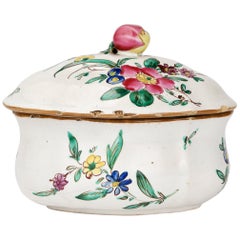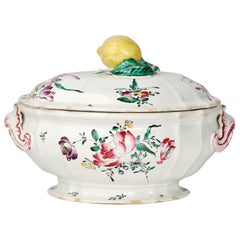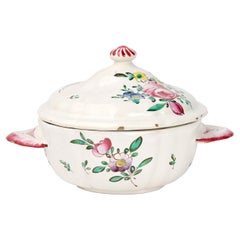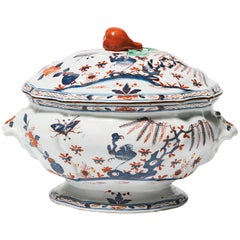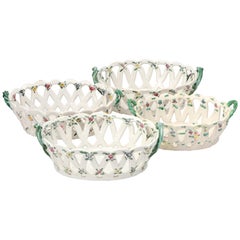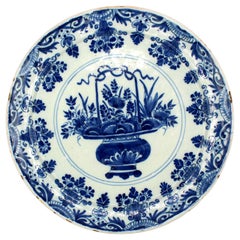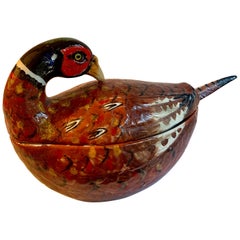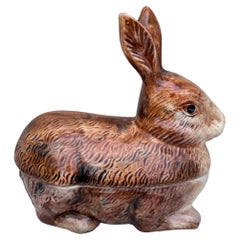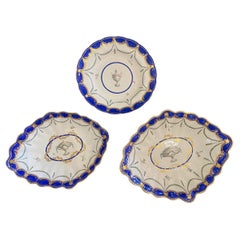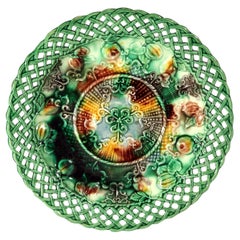1770s Ceramics
to
25
433
1,503
6,953
1,881
971
4,186
1,091
118
46
276
363
212
849
1,130
524
178
71
19
3
25
23
23
1
23
2
24
23
1
1
1
25
25
25
11
8
Period: 1770s
Italian Maiolica Ancient Sugar Bowl, Lodi, 1770-1780
Located in Milano, IT
Maiolica sugar bowl
Antonio Ferretti Manufacture
Lodi, Circa 1770-1780
Maiolica polychrome decorated “a piccolo fuoco” (third fire).
It measures 3.54 x 4.52 x 3.54 in (9 x 11,5 x 9 cm)
Weight: 0.394 lb (0.179 kg)
State of conservation: small and slight chips on the edges.
The small sugar bowl has a swollen and ribbed body resting on a flat base. The cap-shaped lid follows the rib of the container and is topped with a small knob in the shape of a two-colored fruit.
The sugar bowl is painted “a piccolo fuoco” (third fire) with the characteristic floral motif of bunches and isolated semis.
An example which closely corresponds to this one is kept at the Civic Museum in Lodi (G. Gregorietti, Maioliche di Lodi, Milano e Pavia, Catalogo della Mostra, Milano, 1964 n. 137).
This decorative style represented a strong point of the Lodi factory, which established itself thanks to the vivid nature of the colors made possible by the introduction of a new technique perfected by Paul Hannong in Strasbourg and later introduced by Antonio Ferretti to Italy. The production process, called “piccolo fuoco” (third fire), allowed the use of a greater number of colors than in the past; in particular, the purple of Cassius, a red made from gold chloride, was introduced. Its use allowed for many more tones and shades, from pink to purple.
The Ferretti family started their maiolica manufacturing business in Lodi in 1725.
The forefather Simpliciano started the business by purchasing an ancient furnace in 1725 and, indeed, we have evidence of the full activity of the furnaces starting from April of the same year (Novasconi-Ferrari-Corvi, 1964, p. 26 n. 4). Simpliciano started a production of excellence also thanks to the ownership of clay quarries in Stradella, not far from Pavia. The production was so successful that in 1726 a decree of the Turin Chamber came to prohibit the importation of foreign ceramics, especially from Lodi, to protect internal production (G. Lise, La ceramica a Lodi, Lodi 1981, p. 59).
In its initial stages, the manufacture produced maolicas painted with the “a gran fuoco” (double fire) technique, often in turquoise monochrome, with ornamentation derived from compositional modules in vogue in Rouen in France. This was also thanks to the collaboration of painters like Giorgio Giacinto Rossetti, who placed his name on the best specimens next to the initials of the factory.
In 1748 Simpliciano made his will (Gelmini, 1995, p. 30) appointing his son Giuseppe Antonio (known as Antonio) as universal heir. After 1750, when Simpliciano passed away, Antonio was directly involved in the maiolica factory, increasing its fortunes and achieving a reputation on a European level. Particularly important was the aforementioned introduction in 1760 of the innovative “a piccolo fuoco” (third fire) processing, which, expanding the ornamental repertoire with Saxon-inspired floral themes, was able to commercially compete with the German porcelains that had one of its most renowned offerings in the naturalistic Deutsche Blumen. Antonio Ferretti understood and promoted this technique and this decoration, proposing it in a fresher and more corrective version, less linked to botanical tables, both with or without contour lines, as well as in purple or green monochrome. After efforts to introduce more industrial production techniques to the sector succeeded, even the Ferretti manufacture, in the last decade of the eighteenth century, started heading towards decline despite its attempts to adapt production to neoclassical tastes.
In 1796 the Napoleonic battle for the conquest of the Lodi bridge over the Adda definitively compromised the furnaces. Production resumed, albeit in a rather stunted manner, until Antonio's death on 29 December 1810. (M. L. Gelmini, pp. 28-30, 38, 43 sgg., 130-136 (for Simpliciano); pp. 31 sgg., 45-47, 142-192 (for Antonio).
Bibliography
G. Gregorietti, Maioliche di Lodi Milano e Pavia Catalogo della Mostra, Milano, 1964 n. 137;
C. Baroni, Storia delle ceramiche nel Lodigiano, in Archivio storico per la città e i comuni del circondario e della diocesi di Lodi, XXXIV (1915), pp. 118, 124, 142; XXXV (1916), pp. 5-8;
C. Baroni, La maiolica antica di Lodi, in Archivio storico lombardo, LVIII (1931), pp. 453-455;
L. Ciboldi, La maiolica lodigiana, in Archivio storico lodigiano, LXXX (1953), pp. 25 sgg.;
S. Levy, Maioliche settecentesche lombarde e venete, Milano 1962, pp. 17 sgg.;
A. Novasconi - S. Ferrari - S. Corvi, La ceramica lodigiana, Lodi 1964, ad Indicem; Maioliche di Lodi, Milano e Pavia (catal.), Milano 1964, p. 17;
O. Ferrari - G. Scavizzi, Maioliche italiane del Seicento e del Settecento, Milano 1965, pp. 26 sgg.;
G. C. Sciolla, Lodi. Museo civico, Bologna 1977, pp. 69-85 passim; G. Lise, La ceramica a Lodi, Lodi 1981;
M. Vitali, in Storia dell'arte ceramica...
Category
Italian Rococo Antique 1770s Ceramics
Materials
Maiolica
Italian Maiolica Ancient Tureen, Lodi, 1770-1780
Located in Milano, IT
Maiolica tureen
Antonio Ferretti Manufacture
Lodi, circa 1770-1780
Maiolica polychrome decorated “a piccolo fuoco” (third fire).
It measures 9.05 x 12.59 x 9.05 in (23 x 32 x 23 cm)
...
Category
Italian Rococo Antique 1770s Ceramics
Materials
Maiolica
Italian Maiolica Cup Ferretti Lodi, circa 1770 - 1780
Located in Milano, IT
Maiolica puerperal cup
Antonio Ferretti Manufacture
Lodi, Circa 1770 - 1780
Maiolica polychrome decorated “a piccolo fuoco” (third fire).
It measures: 4.3 x 6.8 x 5.3 in (11 x 17,5 x 13,5 cm)
Weight: 0.78 lb (358 g)
State of conservation: some closed pass-through fêlures on the cup, barely visible on the outside. Some use chips on the edge of the lid, two of which are more marked.
From about the mid-sixteenth century, the puerperal soup tureen or puerperal cup became one of the most popular wedding gifts in central Italy. As an auspicious symbol, it replaced the birth table (“desco da parto”) which, on the occasion of high-ranking marriages, from the thirteenth century, had been painted by famous artists, especially in Tuscany.
In France this same tureen is called "écuelle de mariée", as it is given to spouses as a sign of fertility.
During the eighteenth century this custom spread even outside Italy to all social levels. Depending on availability and rank, it was made of different materials: precious metals, maiolica, porcelain, glass, pewter, etc.
Beginning in the mid-twentieth century, the custom of this symbolic homage gradually disappeared, although famous designers such as Gio Ponti and Giuseppe Gariboldi, even as recently as the 1940s, revisited a model of a small puerperal soup bowl for the Ginori and, also in Italy in 1940, in a national competition for young potters, one of the themes of the test was indeed a modern model of a puerperal cup as an auspicious gift.
This particular cup was also called a "service cup" or "puerperal vase" or "stuffed cup" - the windows were sealed with straw to prevent drafts of air for women in labor.
In the eighteenth century the line of the puerpera cup was simplified, so much so that it took the form of a small tureen with two handles - the typical broth cup...
Category
Italian Rococo Antique 1770s Ceramics
Materials
Maiolica
Ancient Italian Maiolica Tureen Milano, 1770 circa
Located in Milano, IT
Maiolica tureen “allo struzzo” (ostrich decoration)
Milan, Felice Clerici or Pasquale Rubati factory, circa 1750-1780
Measures: 9.25 in x 12.79 in x 10.23 in (cm 23.5 x cm 32.5 x cm 26)
lb 4.78 (kg 2.17)
State of conservation, a felûre consolidated inside with slight edge chipping restored.
In Milan in the 18th century two Majolica warehouses were opened, the first, by Felice Clerici, in 1745, the second in 1756 by Pasquale Rubati.
Traditionally this type of decoration has been attributed to the Pasquale Rubati factory. In reality the motif “allo struzzo”, one of the clearest examples of how the taste for chinoiserie met with considerable success during the 18th century, had been produced, in specimens of greater or lesser quality, by both Milanese manufactories.
This Maiolica tureen has a swollen and ribbed oval bowl, rests on an extroflexed foot and shows stirrup handles.
The tri-color ornament, in the typical tones of Japanese "Imari" decorations, shows an idealized oriental landscape that develops around a perforated rock and has a willow tree with long lance-shaped leaves framing the long-legged bird figure. The ornamentation is enhanced by decorative elements such as butterflies, small florets and a vase with a thin flowery stem.
The lid is ribbed with a pear-shaped knob on top.
The decoration was called in the Milanese manufactories "allo struzzo" (ostrich decoration) and this refers to the oriental figure Xian He or the crane, symbol of longevity, here losing its symbolic value. It is hypothesized that among some 16th century engravings...
Category
Italian Chinoiserie Antique 1770s Ceramics
Materials
Maiolica
Two Pairs of Italian Maiolica Baskets, circa 1780
Located in Milano, IT
Two pairs of maiolica baskets
Antonio Ferretti Manufacture
Lodi, circa 1770-1790
Maiolica polychrome decorated “a piccolo fuoco” (third fire).
Measures: A) Height 3.54 x 6.69 x 9.84 in (9 x 17 x 25 cm);
B) Height 3.93 x 7.48 x 11.02 in (10 x 19 x 28 cm).
Total weight 4.85 lb (2.200 kg)
State of conservation:
A) One of the smaller baskets has some areas of restoration, the other slight chipping from use;
B) One of the larger baskets is intact and the other shows a clearly glued break.
The mold with which the baskets were forged simulates a wicker weave.
The two larger works have high, vertical walls, with branch-shaped handles penetrating the weave. The painted decorations, small polychrome flowers applied only externally, highlight the points where the weaves intersect.
The decision to leave the center of the basket devoid of decoration is highly unusual, but given the size and complexity of the shape, as well as the quality of the enamel, it is possible to hypothesize that it represents a precise choice in manufacturing or for a particular client.
The two smaller baskets have small, twisted handles and, on the outside, reproduce more decisively the characteristic wicker weave, obtained through thin molded lines. The interior exhibits a rich, typical decoration of naturalistic flowers: a bunch centered around a main flower and secondary stems accompanied by small “semis”. The exterior of these works is also adorned with small little flowers where the weaves intersect.
The size and morphological characteristics of the baskets confirm their attribution to the Lodi factory of Antonio Ferretti between 1770 and 1790, during its most successful period; by this point his original reworking of the "Strasbourg" decoration, known as "old Lodi", had achieved great fame even outside Italy.
This decorative choice represented a strong point of the Lodi factory, which established itself thanks to the vivid nature of the colors made possible by the introduction of a new technique perfected by Paul Hannong in Strasbourg and which Antonio Ferretti introduced in Italy. This production process, called “piccolo fuoco” (third fire), allowed the use of a greater number of colors than in the past; in particular, the purple of Cassius, a red made from gold chloride, was introduced. Its use allowed for many more tones and shades, from pink to purple.
The Ferretti family had started their maiolica manufacturing business in Lodi in 1725.
The forefather Simpliciano had started the business by purchasing an ancient furnace in 1725 and, indeed, we have evidence of the full activity of the furnaces from April of the same year (Novasconi-Ferrari-Corvi, 1964, p. 26 n. 4). Simpliciano had started a production of excellence also thanks to the ownership of clay quarries in Stradella, not far from Pavia. The production was so successful that in 1726 a decree of the Turin Chamber came to prohibit the importation of foreign ceramics, especially from Lodi, to protect internal production (G. Lise, La ceramica a Lodi, Lodi 1981, p. 59).
In its initial stages, the manufacture produced maolicas painted with the “a gran fuoco” (double fire) technique, often in turquoise monochrome, with ornamentation derived from compositional modules in vogue in Rouen in France. This was also thanks to the collaboration of painters like Giorgio Giacinto Rossetti, who placed his name on the best specimens next to the initials of the factory.
In 1748 Simpliciano made his will (Gelmini, 1995, p. 30) appointing his son Giuseppe Antonio (known as Antonio) as universal heir. After 1750, when Simpliciano passed away, Antonio was directly involved in the maiolica factory, increasing its fortunes and achieving a reputation on a European level. Particularly important was the aforementioned introduction in 1760 of the innovative “a piccolo fuoco” (third fire) processing, which, expanding the ornamental repertoire with Saxon-inspired floral themes, could commercially compete with the German porcelains that had one of its most renowned offerings in the naturalistic Deutsche Blumen. Antonio Ferretti understood and promoted this technique and this decoration, proposing it in a fresher and more corrective version, less linked to botanical tables...
Category
Italian Neoclassical Antique 1770s Ceramics
Materials
Maiolica
Circa 1770 Delft Blue & White Plate
Located in Chapel Hill, NC
Circa 1770 Delft blue & white plate. Central handled & footed basket vase overflowing with flowers, surrounded by alternating repetive floral vases & natura...
Category
Dutch Antique 1770s Ceramics
Materials
Ceramic
Pair of Italian Maiolica Tureens, Ferretti Manufacture, Lodi Circa 1770 - 1780
Located in Milano, IT
Pair of maiolica tureens
Antonio Ferretti Manufacture
Lodi, circa 1770-1780
Maiolica polychrome decorated “a piccolo fuoco” (third fire).
a – 8.66 x 11.02 x 7.48 in (22 x 28 x 19...
Category
Italian Rococo Antique 1770s Ceramics
Materials
Maiolica
Chinese Export Qing Qianlong Famille Rose Medallion Porcelain Bowl
Located in Long Island City, NY
This finely decorated Qing-period rose medallion or rose mandarin bowl is beautifully hand-painted with four vignettes depicting courtly scenes.
Category
Chinese Qing Antique 1770s Ceramics
Materials
Porcelain
Ancient Maiolica Plates Pasquale Rubati, Milan Circa 1770-1780
Located in Milano, IT
Five oval maiolica dishes with pierced edge
Manufacture of Pasquale Rubati
Milan, 1770-1780
Three small oval dishes 10.23 in x 7.67 in (26 cm x 19.5 cm)
Two large oval dishes 10.82 in x 8.85 in (27.5 x 22.5 cm)
lb 3.5 (kg 1.8)
State of conservation: intact
The five dishes of different sizes have an oval shape, a mixtilinear edge and a molded polylobed shape with a surface enriched with a relief weave motif extending to the brim and forming a perforated basket...
Category
Italian Rococo Antique 1770s Ceramics
Materials
Maiolica
Italian Maiolica Tureen, Rubati Manufacture, Milan, circa 1770-1780
Located in Milano, IT
Maiolica tureen
Pasquale Rubati Manufacture
Milan, circa 1770 - 1780
Maiolica polychrome decorated “a piccolo fuoco” (third fire).
It measures 6.69 in x 11,02 x 8.26 (17 x 28 x ...
Category
Italian Rococo Antique 1770s Ceramics
Materials
Maiolica
Small Maiolica Flower Pots, Ferretti Manufacture, Lodi, circa 1770-1780
Located in Milano, IT
Two maiolica flower pots
Antonio Ferretti Manufacture
Lodi, Circa 1770 - 1780
Maiolica polychrome decorated “a piccolo fuoco” (third fire)
The...
Category
Italian Rococo Antique 1770s Ceramics
Materials
Maiolica
Ancient Italian Maiolica Rose Dishes by Pasquale Rubati Milano, 1780 circa
Located in Milano, IT
Assortment of 12 elements with polychrome and gold decoration
Pasquale Rubati Factory
Milan, circa 1770- 1790.
Two oval trays 10.62 in x 8.58 in (27 x 21.8 cm)
Two dishes with perforated brim diameter 10.43 in (26.5 cm)
Eight round dishes 9.37 in (23.8 cm)
lb 10.14 (kg 4.6)
State of conservation: very good, except for light chips with color drops at the edges, a greater one in a round dish.
This rare set of dishes has great decorative impact and confirms the undisputed artistic ability of Pasquale Rubati's productions during the period of his greatest success. It also attests to the taste of the great Milanese commissions of the eighteenth century.
Pasquale Rubati, a refined painter, opened his own factory in Milan in 1756, in competition with Felice Clerici...
Category
Italian Rococo Antique 1770s Ceramics
Materials
Maiolica
Ancient Maiolica Coffee Set “Barbotine” Decoration Milan, 1770- 1780
Located in Milano, IT
Coffee assortment with “barbotine” decoration
Manufacture of Pasquale Rubati or Felice Clerici
Milan, 1770- 1780
Maiolica polychrome decorated “a piccolo fuoco” (third fire).
...
Category
Italian Rococo Antique 1770s Ceramics
Materials
Maiolica
Italian Maiolica Pitcher, Ferretti Manufacture, Lodi Circa 1770 - 1780
Located in Milano, IT
Maiolica pitcher
Antonio Ferretti Manufacture
Lodi, circa 1770-1780
Maiolica polychrome decorated “a piccolo fuoco” (third fire).
It measures 8.66 x 8.66 x 4.33 in (22 x 22 x 11 ...
Category
Italian Rococo Antique 1770s Ceramics
Materials
Maiolica
Ancient Maiolica Dishes with flowers, Lombard Manufacture, 1770-1780 Circa
Located in Milano, IT
Assortment of dishes
Lombard manufacture
1770 – 1780 Circa
Maiolica polychrome decorated “a piccolo fuoco” (third fire).
Two large dishes: diameter 14.76 in (37.5 cm); weight 4.5...
Category
Italian Rococo Antique 1770s Ceramics
Materials
Maiolica
Italian Maiolica Pharmacy Flasks Felice Clerici, Milan Circa 1770-1780
Located in Milano, IT
Two maiolica pharmacy flasks
Milan, Felice Clerici Manufacture, 1770-1780
They each measure 9.44 in (24 cm) in height x 6.10 in (15.5 cm) in diameter
l...
Category
Italian Neoclassical Antique 1770s Ceramics
Materials
Maiolica
Maiolica flower pot "a mezzaluna," Pasquale Rubati Factory, Milan, circa 1770
Located in Milano, IT
Majolica flower pot "crescent" decorated in manganese
Pasquale Rubati Factory
Milan, c. 1770
4.92 in x 8.66 in x 5,31 in
12.5 cm x 22 cm X 13.5 cm
Weight: 2.29 lb (1039 g)
State of conservation: intact with slight chipping due to use in relief parts
A rare example of a flower pot "a mezzaluna" produced by the manufactory of the refined painter Pasquale Rubati, who opened a factory in Milan in 1756 to compete with Felice Clerici...
Category
Italian Rococo Antique 1770s Ceramics
Materials
Maiolica
Four Italian Ancient Dishes, Antonio Ferretti, Lodi, circa 1770-1780
Located in Milano, IT
Assortment of 4 dishes with braided rim
Antonio Ferretti Manufacture
Lodi, circa 1770-1780
Maiolica polychrome decorated “a piccolo fuoco” (third fire).
Measures: 14 x 10 in (35.5 x 25.5 cm);
12.2 x 8.39 in (31 x 21.3 cm);
10.4 x 9.65 in (26.5 x 24.5 cm);
10.8 x 9.61 in (27.5 x 24.4 cm).
Weight: 4.4 lb (1.998 kg)
State of conservation: some chips due to use on the edges and on the parts in relief.
The four different dishes have a foot with a low lip from which extends a wide, flat, slanted rim resembling a basket weave. The small handles are painted green: they resemble wickerwork in the two oval dishes and take the form of a sinuous branch in the round ones.
The third fire decoration is inspired by the naturalistic floral botanical patterns on the ceramics produced by the Hannong family in Strasbourg. Here the pattern is defined by the rapidity and subtlety of the brushstrokes and the result is particularly tasteful, characterized by compositional intelligence and pictorial expertise.
A main corolla, either a wild or garden rose, is set slightly off center in each well. From this extends a thin stem holding a small secondary bud and there are small field florets dotting the composition to lend volume to the delicate bunch of flowers.
On the brim, small polychrome flowers add color to the weave, accompanied by lanceolate leaves of a very intense green.
There exist few and very rare examples for comparison with this morphology: a round plate - entirely consistent with those in question - has been dated to around 1775 (S. Levy, Maioliche settecentesche lombarde e venete, Milano 1962, tav. 200). Two other dishes with a basket rim, but with parallel striped brim decoration, were exhibited in the 1995 exhibition on Lodi ceramics; the attribution to the Lombard town near Milan is therefore almost exclusively derived from the decoration called "alla rosa contornata" or "alla vecchia Lodi" and constitutes one of the most popular decorations during the eighteenth century. (M. L. Gelmini, in Maioliche lodigiane del '700 (cat. mostra Lodi), Milano 1995, pp. 31 p. 162-163 nn. 181-182).
This decorative choice represented a strong point of the Lodi factory, which established itself thanks to the vivid nature of the colors made possible by the introduction of a new technique perfected by Paul Hannong in Strasbourg and which Antonio Ferretti introduced in Italy. This production process, called “piccolo fuoco” (third fire), allowed the use of a greater number of colors than in the past; in particular, the purple of Cassius, a red made from gold chloride, was introduced. Its use allowed for many more tones and shades, from pink to purple.
The Ferretti family had started their Maiolica manufacturing business in Lodi in 1725.
The forefather Simpliciano had started the business by purchasing an ancient furnace in 1725 and, indeed, we have evidence of the full activity of the furnaces from April of the same year (Novasconi-Ferrari-Corvi, 1964, p. 26 n. 4). Simpliciano had started a production of excellence also thanks to the ownership of clay quarries in Stradella, not far from Pavia. The production was so successful that in 1726 a decree of the Turin Chamber came to prohibit the importation of foreign ceramics, especially from Lodi, to protect internal production (G. Lise, La ceramica a Lodi, Lodi 1981, p. 59).
In its initial stages, the manufacture produced maolicas painted with the “a gran fuoco” (double fire) technique, often in turquoise monochrome, with ornamentation derived from compositional modules in vogue in Rouen in France. This was also thanks to the collaboration of painters like Giorgio Giacinto Rossetti, who placed his name on the best specimens next to the initials of the factory.
In 1748 Simpliciano made his will (Gelmini, 1995, p. 30) appointing his son Giuseppe Antonio (known as Antonio) as universal heir. After 1750, when Simpliciano passed away, Antonio was directly involved in the Maiolica factory, increasing its fortunes and achieving a reputation on a European level. Particularly important was the aforementioned introduction in 1760 of the innovative “a piccolo fuoco” (third fire) processing, which, expanding the ornamental repertoire with Saxon-inspired floral themes, could commercially compete with the German porcelains that had one of its most renowned offerings in the naturalistic Deutsche Blumen. Antonio Ferretti understood and promoted this technique and this decoration, proposing it in a fresher and more corrective version, less linked to botanical tables...
Category
Italian Neoclassical Antique 1770s Ceramics
Materials
Maiolica
Ancient Maiolica Flower Pot Pasquale Rubati Factory, Milan Circa 1770
Located in Milano, IT
Maiolica flower pot “a mezzaluna” decorated with tulip
Pasquale Rubati Factory
Milan, circa 1770.
Measures: 4.7 in x 4.7 in x 8.6 in
12 cm x 12...
Category
Italian Rococo Antique 1770s Ceramics
Materials
Maiolica
Ancient Maiolica Cup, Rubati Manufacture, Milan, Circa 1770 - 1780
Located in Milano, IT
Sick cup
Pasquale Rubati Manufacture
Milan, Circa 1770 - 1780
Maiolica decorated in polychrome “a piccolo fuoco” (third fire)
It measures: h 2.36 x 7.4 x 7.87 (h 6 x 19 x 20 cm)
...
Category
Italian Rococo Antique 1770s Ceramics
Materials
Maiolica
Pair of Ancient Italian Maiolica Flower Pots Milan, Rubati Factory, 1770 circa
Located in Milano, IT
Maiolica flower pot “a mezzaluna”
decorated with trompe l’oeil
Pasquale Rubati Factory
Milan, circa 1770
Measures: each 4.7 in (cm 12) x 5 in (c...
Category
Italian Rococo Antique 1770s Ceramics
Materials
Maiolica
Maiolica Oval Tray, Felice Clerici Manufactory, Milan, Circa 1770-1780
Located in Milano, IT
Small oval tray
Felice Clerici Manufactory 1745-1780
Milan, Circa 1770-1780
Maiolica polychrome.
Dimensions: 10.82 x 8.66 in (27.5 x 22 cm); weight 0.4...
Category
Italian Rococo Antique 1770s Ceramics
Materials
Maiolica
Italian Maiolica Flower Pot Garlands of Flowers, P. Rubati, Milano, 1770 circa
Located in Milano, IT
Maiolica flower pot “a mezzaluna”
decorated with garlands of flowers
Pasquale Rubati Factory
Milan, circa 1770
Measures: 4.7 in x 5 in x 8.8 in
...
Category
Italian Rococo Antique 1770s Ceramics
Materials
Maiolica
Antique Italian Maiolica Coolers Pasquale Rubati Manufacture Milan, 1770 Circa
Located in Milano, IT
Assortment of bottle and glass coolers in Maiolica.
Pasquale Rubati manufacture
Milan, circa 1770
Maiolica polychrome decorated “a piccolo fuoco” (third fire)
a - Bottle cooler
5.91 in x 5.91 in diameter (15 x 15 cm )
Weight: 1.86 lb (845 g)
b - Bottle cooler
6.89 x 7.87 in diameter (17,5 x 20 cm)
Weight: 2.09 lb (948 g)
c - Pair of glass-cooler vases
3.94 x 3.94 in diameter (10 x 10 cm)
Weight: 1.43 lb (650 g)
Good state of conservation:
a - some chipping from use on the edge;
a - two fêlures covered on the edge;
c - one has deep chippings on the edge and the other a subtle fêlure.
Two Majolica factories were active in Milan in the 18th century. The first, starting from 1745, was owned by Felice Clerici; the other one by Pasquale Rubati from 1756. Rubati was in competition with Felice, whose worker he had been prior to opening his own workshop. On his death in 1796, the business was continued for a few more years by his son Carlo.
Recent studies have recognized Pasquale Rubati's contribution as the creator of "Strasbourg-style" decorations with their particularly joyful depictions. This style had previously been attributed to the Lodi manufacturers. These works here, however, are a clear example of this production.
The Majolica containers have different sizes, a cylindrical shape and rest on a low foot ring. The two largest are completed by handles in the shape of a zoomorphic mask with wide open jaws, while the smaller ones have handles applied with an anthropomorphic mask.
All the works are characterized by elegant floral decoration.
The two twin glass coolers show bunches of flowers centered around a main corolla, a rose or a peony paired...
Category
Italian Rococo Antique 1770s Ceramics
Materials
Maiolica
Rococo Italian Maiolica Flower Pot Pasquale Rubati, Milano, 1770 circa
Located in Milano, IT
Maiolica flower pot “a mezzaluna” with support feet
decorated with little bunches of flowers
Pasquale Rubati Factory
Milan, circa 1770
5.5 in X ...
Category
Italian Rococo Antique 1770s Ceramics
Materials
Maiolica
Related Items
Italian Oggetti Porcelain Pheasant Soup Tureen with Ladle
By Oggetti
Located in Los Angeles, CA
Italian hand painted Porcelain pheasant soup gravy tureen with ladle by Oggetti. A cleaver soup or gravy tureen covered by a hand painted bird like form. A wonderful piece for sharin...
Category
Italian 1770s Ceramics
Materials
Ceramic, Porcelain
Majolica Brown Rabbit Tureen Caugant
Located in Austin, TX
French Majolica rabbit tureen signed Caugant, circa 1940.
Category
French Country Vintage 1770s Ceramics
Materials
Ceramic, Faience, Majolica
Large Masons Ironstone Punch Bowl in Curled Leaf & Flower Basket ptn, circa 1838
Located in Lincoln, Lincolnshire
This is a Large twin Handled open Punch Bowl made by Mason's Ironstone in a beautiful pattern called: Curled Leaf and flower Basket, made in the early 19th century, William 1Vth peri...
Category
English William IV Antique 1770s Ceramics
Materials
Ironstone
H 6 in W 12.75 in D 10.25 in
NINE antique Delft Wall Tiles Blue & White scenes, Netherlands mainly 18th C
Located in Lincoln, Lincolnshire
These are NINE Delft ceramic wall tiles, all with different blue and white hand painted patterns, made in the Netherlands, from the 19th Century to the 17th Century, but mainly 18th Century.
Each tile is nominally slightly over 5 inches square..
All nine tiles are unique, being individually hand painted with different scenes and patterns featuring various scenes with buildings, trees, watersides, boats and one floral, with most having spider motif corners. They are all enamelled in cobalt blue, using different shades of blue, which varies slightly from tile to tile as expected:- please see the images.
Two of the tiles have scenes within double blue circles.
NOTES:
The central floral pattern tile is slightly thicker and dates to the 17th C
Seven Tiles are 18th Century and one is 19th Century ( blue tinged glaze)
Overall a beautiful set of individual hand painted antique Delft tiles...
Category
Dutch Dutch Colonial Antique 1770s Ceramics
Materials
Earthenware
H 0.3 in W 5.15 in D 5.15 in
Italian solid silver 800's tureen in baroque style
Located in VALENZA, IT
Baroque style oval tureen, made entirely by hand.
The baroque style of this tureen is very light with grooves typical of the style but not evident to allow the object to be easily pl...
Category
Italian Baroque 1770s Ceramics
Materials
Silver
Italian Neo-Classical Grand Tour Style Ram’s Head Stirrup Cup
Located in Kennesaw, GA
This is an Italian neo-classical Grand Tour ram’s head form stirrup cup. The composition is pottery with an almost bisque-like finish.
Category
Italian Neoclassical 1770s Ceramics
Materials
Pottery
Majolica Doe Tureen Caugant, circa 1950
Located in Austin, TX
Rare Majolica doe tureen signed Caugant, circa 1950.
Category
French Country Vintage 1770s Ceramics
Materials
Ceramic
Abigail Griffith’s Rare Lambeth Delft Plate-England, 18th Century
By Abigail Griffith
Located in West Palm Beach, FL
A rare 9" Lambeth Delft plate:
"An English Delftware tin-glazed charger attributed to the Abigail Griffith London Lambeth pothouse. Great decorative blue and white delftware- boldly ...
Category
English George III Antique 1770s Ceramics
Materials
Pottery
Vintage Large Italian Porcelain Duck Tureen
Located in West Palm Beach, FL
Hand painted Italian Porcelain Duck Tureen. A very fine piece that will make your table special.
Category
Italian 1770s Ceramics
Materials
Porcelain
Majolica Brown Rabbit Tureen Caugant
Located in Austin, TX
French Majolica rabbit tureen signed Caugant, circa 1940.
Category
French Country Vintage 1770s Ceramics
Materials
Ceramic, Faience, Majolica
Vintage Blue and White Delft Porcelain Spoon Rack
Located in North Hollywood, CA
Stunning Vintage Delfts Blauw blue and white porcelain spoon rack in very good condition.
Beautiful Dutch Delft hanging wall rack with blue and white han...
Category
Dutch Folk Art 1770s Ceramics
Materials
Ceramic, Porcelain
Blue & White Ridgway Sauce Tureen Staffordshire
(Italian Scenery)
Located in Huntington, NY
Blue & White Ridgway Sauce Tureen Staffordshire
(Italian Scenery)
Category
English William IV Antique 1770s Ceramics
Materials
Ceramic
Previously Available Items
Three Chelsea-Derby Porcelain Pieces
Located in Charlottesville, VA
Three Chelsea-Derby porcelain pieces, circa 1775. Central urn cartouche flanked by musical instruments having a cobalt border and gilt accents. The two serving pieces with of scallop...
Category
English Antique 1770s Ceramics
Materials
Ceramic, Porcelain
Whieldon-Type Creamware Dish with Molded Fruit and Openwork Border
Located in Downingtown, PA
English creamware openwork dish with moulded fruit
Whieldon,
circa 1775.
The circular lead-glazed cream-coloured earthenware dish has a basket weave openwork border with an inne...
Category
Georgian Antique 1770s Ceramics
Materials
Creamware, Pottery
Italian Ceramic Animal Figure by Roberto Rigon
Located in Byron Bay, NSW
Italian ceramic animal figure by Roberto Rigon Italy 1970s.
In exceptional Roberto Rigon weasel in 'Smalto Sasso' [glazed stone] with yellow, ...
Category
Italian Mid-Century Modern Antique 1770s Ceramics
Materials
Ceramic
18th Century, Italian Maiolica Flower Pot, Pasquale Rubati, Milan, 1770 circa
Located in Milano, IT
Maiolica flower pot “a mezzaluna”
decorated with trompe l’oeil
Pasquale Rubati Factory
Milan, 1770 circa
It measures: 4.7 in (cm 12) X 5 in (...
Category
Italian Rococo Antique 1770s Ceramics
Materials
Maiolica
H 4.73 in W 8.82 in D 5.04 in
Pair of Italian Maiolica Flower Pots, Antonio Ferretti, Lodi, circa 1770 – 1780
Located in Milano, IT
Pair of flower pots
Antonio Ferretti Manufacture
Lodi, circa 1770 – 1780
Maiolica polychrome decorated “a piccolo fuoco” (third fire)
They meas...
Category
Italian Rococo Antique 1770s Ceramics
Materials
Maiolica
H 4.73 in W 6.7 in D 5.71 in
Italian Ancient Maiolica Tureen, Lodi, 1770-1780
Located in Milano, IT
Maiolica tureen
Antonio Ferretti Manufacture
Lodi, Circa 1770 - 1780
Maiolica polychrome decorated “a piccolo fuoco” (third fire).
It measures 7.48 x 7.48 x 11.02 in (19 x 19 x 2...
Category
Italian Rococo Antique 1770s Ceramics
Materials
Maiolica
Chinese Blue and White Small Platter Made circa 1770 during the Qianlong Period
Located in Katonah, NY
A Chinese blue and white platter hand-painted in beautiful underglaze cobalt blue during the Qianlong period, circa 1770. The center is ...
Category
Chinese Qing Antique 1770s Ceramics
Materials
Porcelain
H 0.8 in W 7.25 in D 10 in
Italian Maiolica Service Pasquale Rubati Milano with Green Flowers, circa 1780
Located in Milano, IT
Assortment of 21 maiolica service elements
Pasquale Rubati Factory
Milan, 1780 circa
a. Four large oval dishes or fish dishes 10.43 in x 21.25 in (26.5 c...
Category
Italian Rococo Antique 1770s Ceramics
Materials
Maiolica
H 1.19 in W 21.26 in D 10.44 in
18th Century Italian Terracotta Chinoiserie Vase, circa 1770
Located in Milano, IT
Terracotta vase with lid decorated with “chinoiserie” subjects "a lacca povera" on a green background
Turin or Venice, second half of the 18th century
Measures: 26.37 inches in hei...
Category
Italian Chinoiserie Antique 1770s Ceramics
Materials
Terracotta, Paper
18th Century Italian Maiolica Armorial Dish Milano, circa 1770
Located in Milano, IT
A Maiolica dish, "Famille Rose" decoration
with the coat of arms of the Marquis Olivera
Felice Clerici Factory
Milan, 1770-1780
9.05 in (23 cm) in diam...
Category
Italian Rococo Antique 1770s Ceramics
Materials
Maiolica
18th Century Italian Maiolica Dish Milano, circa 1770
Located in Milano, IT
Maiolica dish, "Famille Rose" and gold decoration
Felice Clerici factory
Milan, 1770-1780
8.93 in (22.27 cm) in diameter
lb 0.66 (kg 0.3)
State of conservation: perfect, except for slight chipping at the edges
The dish is rare example of a service produced by the factory of Felice Clerici (1710-1780) in Milan.
Felice Clerici had opened his own factory in Milan in 1745, inserting himself into the new European stylistic trend which saw Maiolica becoming a Fine product like porcelain. The Milanese entrepreneur worked in the early period with high fire furnaces, declaring only in 1759 that he had purchased "the secrets of the paintings by force of money," by which he meant he now could obtain colors with a greater chromatic range with a low fire.
The dish belonged to a particularly refined assortment, which, thanks to the lightly blue glaze and the skilful use of the palette, ought to give the impression of resembling completely the contemporary Chinese works.
The plate is a fund with an especially thin thickness, smooth edge and a barely detectable ring foot. Along the edge there is a thin orange and gold band with a chain of small spirals whereas along the brim there is a typical oriental decoration with peonies and chrysanthemums and minor florets. The flounce hosts a motif "in reserves" centered inside alternating flower and trellis motifs on pink and green backgrounds; among the other elements some flowers made in gold Stand out. In the center an oriental floral ornament is developed around a sturdy branch. On the back the "fraction" brand by Felice Clerici in black.
Raffella Ausenda, while cataloging a Maiolica in the same model as ours, conserved in the collections of the Museo di Arti Applicate del Castello in Milan (to which we refer for comparison), highlights that the ornamentation is directly inspired by Chinese porcelain from the Kang'hsi period known as "Famille Rose". The Clerici manufacture had in fact such a technical command of colors that it could perfectly imitate the oriental models even thanks to the aid of painters such as Giuseppe Sormani and Giacomo Facchetti who “painted with enamel in gold and silver colors. They imitate and accompany porcelain".
The recent publication, edited by the same scholar (R. Ausenda in J.V.G. Mallet and E.P. Sani, a cura di, Maiolica in Italy and Beyond. pp. 124-140), underlines how the rebirth of maiolica in northern Italy also sprang from the experiences of the Milanese factory of Pasquale Rubati. This factory, established in 1756, obtained very high quality products, even considered among the best of the time. In the study she remarks how the pieces produced in the factory so closely matched Chinese...
Category
Italian Rococo Antique 1770s Ceramics
Materials
Maiolica
Ancient Pair of Italian Maiolica Dishes Milano, circa 1770
Located in Milano, IT
Two maiolica dishes, "Famille Rose" decoration
Felice Clerici Factory
Milan, 1770-1780
9.13 in (23.2 cm) each in diameter
lb 1.32 (kg 0.6)
State of conservation: perfect, except for slight chipping at the edges
The dishes are rare examples of a service produced by the factory of Felice Clerici (1710-1780) in Milan.
Felice Clerici had opened his own factory in Milan in 1745, inserting himself into the new European stylistic trend which saw maiolica becoming a fine product like porcelain. The Milanese entrepreneur worked in the early period with high fire furnaces, declaring only in 1759 that he had purchased "the secrets of the paintings by force of money," by which he meant he now could obtain colors with a greater chromatic range with a low fire.
The two dishes are funds with lightly blue glaze. Smooth barely detectable rim and ring foot. Along the edge there is a thin orange band with a chain of small spirals whereas along the brim there is a typical oriental decoration with peonies and chrysanthemums and minor florets. The flounce hosts a motif "in reserves" centered inside alternating flower and trellis motifs on pink and green backgrounds. In the center an oriental floral ornament is developed around a sturdy branch.
On the back the "fraction" brand by Felice Clerici in black.
Raffella Ausenda, while cataloging a maiolica in the same model as ours, conserved in the collections of the Museo di Arti Applicate del Castello in Milan (to which we refer for comparison), highlights that the ornamentation is directly inspired by Chinese porcelain from the Kang'hsi period known as "Famille Rose". The Clerici manufacture had in fact such a technical command of colors that it could perfectly imitate the oriental models even thanks to the aid of painters such as Giuseppe Sormani and Giacomo Facchetti who “painted with enamel in gold and silver colors. They imitate and accompany porcelain".
The recent publication, edited by the same scholar (R. Ausenda in J.V.G. Mallet and E.P. Sani, a cura di, Maiolica in Italy and Beyond. pp. 124-140), underlines how the rebirth of maiolica in northern Italy also sprang from the experiences of the Milanese factory of Pasquale Rubati. This factory, established in 1756, obtained very high quality products, even considered among the best of the time. In the study she remarks how the pieces produced in the factory so closely matched Chinese...
Category
Italian Rococo Antique 1770s Ceramics
Materials
Maiolica
